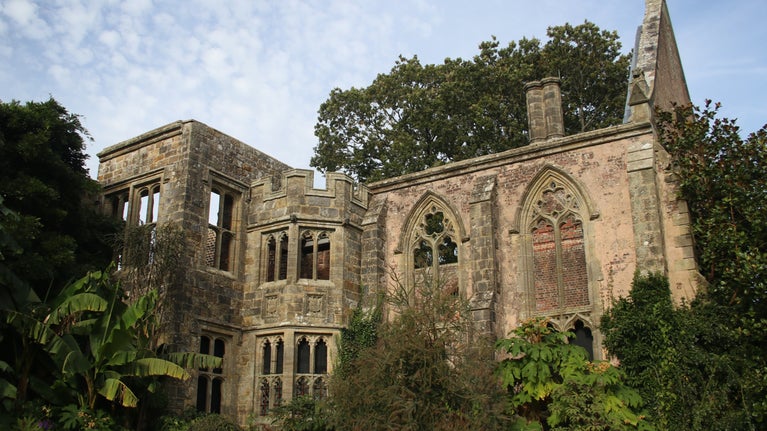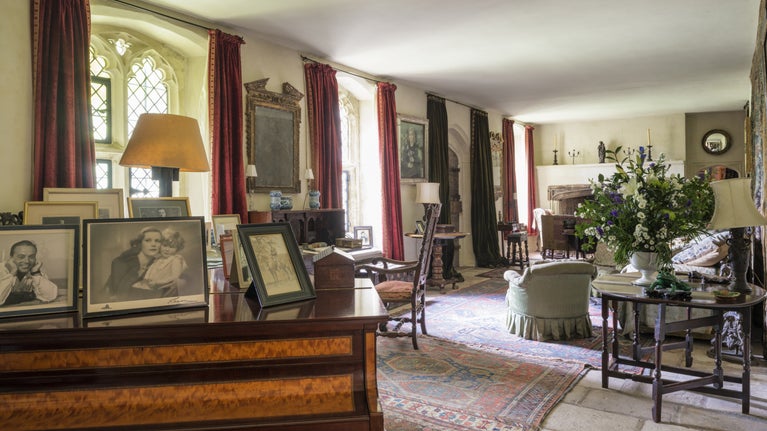
Discover more at Nymans
Find out when Nymans is open, how to get here, the things to see and do and more.

Generations of Messels have lived at Nymans in West Sussex since the 1890s. Their creativity and passion for collecting have shaped the house and garden through wartime, fire and storms, developing one of the most significant plant collections in the National Trust.
Nymans takes its name from Philip Nynian, who owned the estate in the 14th century. After three centuries of agricultural use by the Gatland family and others, Nymans became the country residence of a succession of industrialists in the early 19th century. They enlarged the estate and planted ornamental trees in the garden. The medieval house was largely rebuilt in 1839.
In 1865, Ludwig Messel (1847–1915) left his home in Germany and arrived in London. He worked for stockbrokers Seligman Brothers before establishing his own stockbroking firm, L. Messel and Co. in 1873. Ludwig was an astute businessman, and the firm became one of the most successful in London.
Ludwig became a British citizen in 1869. Two years later he married Annie Cussans (1846–1920). They lived in a fashionable house near Hyde Park and had four daughters and two sons. Shortly after the birth of their youngest daughter, Muriel, they bought Nymans as a country retreat for the family.
Becoming part of the landed gentry was particularly pertinent for Ludwig. As a German Jew, the purchase of a country estate was seen as the ideal way to integrate into British society.
Ludwig asked his brother Alfred Messel (1853–1909), a practising architect in Germany, to remodel the existing house at Nymans. He transformed the building in the Germanic style, adding a tower, large sloping roofs and a vast conservatory. The result appeared somewhat incongruous in the Sussex landscape. Laying out the garden Already a collector of art and antiques, Ludwig turned his attention to collecting rare plants. The soil and conditions at Nymans were ideal for growing the trees and shrubs newly introduced from China, Japan, North America and the Himalayas, and Ludwig began laying out a garden.
Ludwig was fortunate in his choice of Head Gardener. James Comber (1866–1953) began working at Nymans in 1895 and remained employed until his death nearly six decades later. Theirs was a perfect partnership, with Ludwig providing the inspiration and Comber the horticultural expertise. Together they experimented with breeding new cultivars, and many of their original plants still grow at Nymans today.
Ludwig laid out the Arboretum, Wall Garden, Heath Garden, Croquet Lawn, Rock Garden and Pergola, as well as ornamental features in the woodland. Although the garden was filled with rare and interesting plants, Ludwig’s eye for design ensured the planting was ornamental and the layout carefully conceived.
Annie and Ludwig’s youngest daughter Muriel Messel (1889–1918) followed in her father’s footsteps and became a keen plantswoman. As a teenager, she designed the spring borders in the Wall Garden and assisted with the running of the garden when her father became ill. When Ludwig died in 1915, Muriel completed the work he had begun to create a catalogue of his plant collection. This was published in 1918 as ‘A Garden Flora’, with a preface by the renowned horticulturist William Robinson and illustrations by Alfred Parsons. Muriel’s contribution to the garden at Nymans was cut short when she died, aged 29, in the influenza pandemic of 1918.
On his father’s death in 1915, Leonard Messel (1872–1953) inherited Nymans. His wife Maud Messel (1875–1960) was reluctant to move from their comfortable country home nearby in Balcombe. She agreed on condition that the house would be completely remodelled.
This second major transformation of Nymans took place in the 1920s to plans by architect Norman Evill, who was later replaced by Walter Tapper. Maud closely supervised the design of the house which was a 20th-century reimagining of a medieval manor. This picturesque pastiche provided the perfect setting for the Messels’ collection of furniture, textiles and paintings, as well as the library of rare botanical books collected by Leonard.
While Maud created her dream house, Leonard focused on developing the plant collections, working closely with Comber as his father had done. Leonard sponsored the plant collecting trips of Ernest Wilson and George Forrest to China, introducing many new rhododendrons to the garden. Nymans also benefitted from the plants brought back to Britain from Chile and Tasmania by Comber’s son, Harold (1897–1969). The garden gained a reputation for its rare plants, particularly magnolias, camellias and rhododendrons, winning many awards at Royal Horticultural Society shows. Over thirty plants are named after the Messels and Nymans, including Camellia ‘Maud Messel’, Magnolia loebneri 'Leonard Messel' and Davidia involucrata ‘Nymans Sentinel’. Maud’s interest in old-fashioned roses led to the creation of a rose garden in the 1920s to display her collection. She sourced lost varieties and protected many species from extinction.

The youngest of Maud and Leonard’s children, Oliver Messel (1904–78) spent much of his childhood at Nymans with his siblings Lindley and Anne. After attending the Slade School of Art, Oliver began designing sets and costumes for theatre and film, and by the 1940s was recognised as Britain’s leading theatre designer. He also decorated interiors for domestic and commercial clients, including the renowned Messel Suite at the Dorchester Hotel.
Oliver spent the final decade of his life in Barbados with his partner Vagn Riis-Hansen, focussing his artistic talent on architecture. His most famous commission was the house he designed on the island of Mustique for Princess Margaret.
Throughout his career, Oliver campaigned against racism. In the 1970s he refused to allow his production of the ballet ‘Sleeping Beauty’ to be performed in apartheid South Africa, and in 1948 he campaigned against the mistreatment of Seretse Khama, the deposed King of Bechuanaland (now the Republic of Botswana).
Oliver and his sister Anne Messel (1902–92) were both part of the social set known as the Bright Young Things. Later, Anne’s son Anthony Armstrong-Jones became a leading photographer in society, fashion and theatre. He established royal connections and in 1960 married Princess Margaret, taking the title Earl of Snowdon. On her second marriage, Anne became the Countess of Rosse. She was a keen preserver of her family history. She was also a founder member of the Victorian Society, campaigning to save buildings in peril.
During the Second World War, Leonard and Maud welcomed children from a London school who were evacuated to Nymans. The Great Hall was made into a dormitory for 16 boys, and they were encouraged to help in the garden. Leonard had been debarred from military service in the First World War due to his close family connections with Germany. However, he was able to contribute to the war effort by training soldiers from the Fourth Reserve Battalion of the East Kent Regiment.
In the middle of the night on 19 February 1947, Leonard’s 75th birthday, the household at Nymans awoke to the smell of smoke. By the following morning, most of the house had been destroyed by fire. Everyone was safely evacuated, and some of the furnishings were salvaged, but much was lost, including Leonard’s irreplaceable collection of botanical books. With rationing and restrictions on building materials still in place after the end of the Second World War, the family were unable to rebuild the house. They moved to nearby Holmsted Manor but continued to garden at Nymans. The house became a romantic ruin, with some of the areas less damaged by fire made habitable for occasional use.
To ensure the continued upkeep of the garden, Leonard bequeathed Nymans to the National Trust on his death in 1953. Anne remained closely involved in the presentation of the garden.
Alistair Buchanan, Ludwig’s great-grandson, took on an advisory role, just before the great storm of 1987 caused significant damage to the garden. Around 500 trees were destroyed, including 40 champion trees. Some have since been replanted from cuttings.
The garden continues to evolve under the care of National Trust gardeners with input from the Messel family. National Trust gardeners are developing the plant collections and collaborating with botanic gardens around the world, and plants from Nymans continue to win prizes at horticultural shows.
Towards the end of her life, Anne returned to live at Nymans. Following her death in 1992, the rooms in the western range of the house were opened to visitors, displaying the Messel family’s furniture, textiles and paintings. Visitors can now go upstairs where some bedrooms are used for temporary exhibitions, and more of the Messel family’s collection is returning. Most recently, in 2019, a peaceful garden was created within the ruins of the Great Hall.
Shirley Nicholson, Nymans: The Story of a Sussex Garden, 1992
Thomas Messel, Oliver Messel: In the Theatre of Design, 2011
John Hilary, From Refugees to Royalty: The Remarkable Story of the Messel Family of Nymans, 2021
National Trust Heritage Records Online
Historic England: Nymans (Listed Building)
Historic England: Nymans (Garden and Parkland)

Find out when Nymans is open, how to get here, the things to see and do and more.
Some of the country houses in our care tell Jewish stories. Learn about the lives and homes of prominent Jewish people from the worlds of politics, business and literature – how they integrated into 19th and 20th-century British society, and the obstacles and prejudice they encountered as they did so.

Discover some of the finest historic gardens in our care and how they were shaped by Victorian plant collectors, as they gathered plant species from across the globe.

Explore the objects and works of art we care for at Nymans on the National Trust Collections website.

Learn more about the LGBTQ+ people with connections to the places we care for and why highlighting their stories is important.

Learn about people from the past, discover remarkable works of art and brush up on your knowledge of architecture and gardens.
